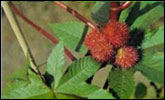| Contents |
 |
|
Page last reviewed: 03/05/2008
|
| Highlights |
 |
|
|

Ricin
Ricin is a toxin that can be made from the waste left over from processing castor beans. It is one of the most toxic and easily produced plant toxins. If injected, as little as 500 micrograms of ricin could be enough to kill an adult; some animal research indicates that similar amounts could be lethal, if inhaled. A 500 microgram dose of ricin would be about the size of the head of a pin. Ricin has been used in the past as a bioterrorist weapon and remains a serious threat.
There are currently no specific OSHA standards or directives for ricin.
OSHA Standards
This section highlights OSHA standards, preambles to final rules (background to final rules), and directives (instructions for compliance officers) generally applicable to emergency response activities associated with a bioterrorist attack.
Refer to the Emergency Preparedness and Response Safety and Health Topics Page for additional information.
Note:
Twenty-five states, Puerto Rico and the Virgin Islands have
OSHA-approved State Plans and have adopted their own standards and enforcement policies. For the most part, these States adopt standards that are identical to Federal OSHA. However, some States have adopted different standards applicable to this topic or may have different enforcement policies.
General Industry (29
CFR 1910)
Preambles to Final Rules
Directives
Hazard Recognition
The discovery of ricin on a mail-opening machine closed
three Senate office buildings in early February, 2004. Although no illnesses or
deaths resulted, using ricin as a bioterrorist weapon in the workplace remains a
serious threat. The following references aid in recognizing disease
characteristics and hazards associated with ricin.
-
Ricin. Centers for Disease Control and Prevention (CDC).
- TOXNET for Ricin. The National Library of Medicine Hazardous Substance Database.
-
Ricin
Toxin From Castor Bean Plant, Ricinus communis. Cornell University, (2001, October 4).
- CBRNE - Ricin. eMedicine, (2004, February 3).
- Medical Management of Biological Casualties Handbook Seventh Edition [2 MB PDF, 254 pages]. US Army Medical Research Institute of Infectious Diseases (USAMRIID), (2011, September). Contains specific information on a number of potential bioterrorist agents.
- Office of The Surgeon General, Department of the Army. "Medical Aspects of Chemical and Biological Warfare."
Textbook of Military Medicine, Part I. Warfare, Weaponry, and the Casualty, (1997).
Ricin as a Weapon
Ricin may have significance as a biological weapon since
it is easy to produce and is stable. In addition to being found on the US
Capital, the ricin toxin has also been used or suspected during the following
instances:
- Ricin was considered for weaponization by the United States during its
offensive Biological Warfare Program. Such a weapon was tested but
apparently never used in battle.
- Ricin was used in the highly publicized assassination of Bulgarian
defector Georgi Markov in 1978. An attacker used an umbrella rigged with a
special tip to inject a ricin pellet under Markov's skin.
- Some reports have indicated that ricin may have been used in the Iran-Iraq
war during the 1980s, and that quantities of ricin were found in Al Qaeda
caves in Afghanistan.
- Two tax protestors were convicted in 1995 under the Anti-Terrorism Act for
possessing ricin as a biological weapon.
- A retired electrician was arrested in 1995 under the Anti-Terrorism Act
for possessing castor beans. Two years before, a large quantity of ricin
toxin, weapons, ammunition, and gold were found in his car by Canadian
customs officials as he crossed the border from Alaska to Canada.
- In October, 2003, an envelope with a threatening note and a sealed
container with ricin was discovered at a mail processing and distribution
facility in Greenville, South Carolina. No ricin-associated illnesses were
identified as a result of the incident.
Additional Information
Related Safety and Health Topics Pages
Other Resources
- Evacuation
Planning Matrix. OSHA.
- Report an Emergency. Centers for Disease Control and Prevention (CDC).
Recommends that health care professionals contact their local
and/or state health department. This link provides a list of health
department websites and emergency notification procedures for use by health
officials and healthcare providers.
Accessibility Assistance: Contact the OSHA Directorate of Technical Support and Emergency Management at (202) 693-2300 for assistance accessing PDF materials.
|


 Newsletter
Newsletter RSS Feeds
RSS Feeds Print This Page
Print This Page
 Text Size
Text Size

